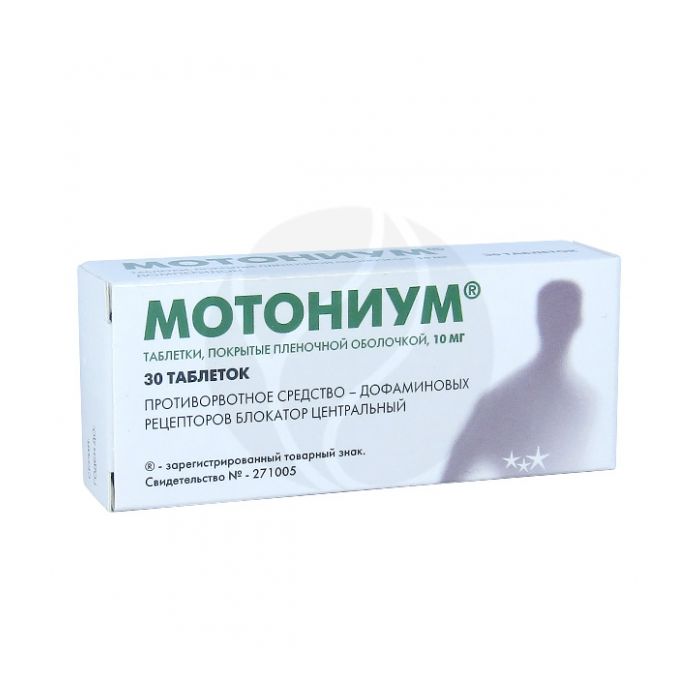Motonium tablets 10mg, No. 30
Expiration Date: 11/2025
Russian Pharmacy name:
Мотониум таблетки 10мг, №30
A complex of dyspeptic symptoms associated with delayed gastric emptying, gastroesophageal reflux, esophagitis:
a feeling of fullness in the epigastrium, a feeling of bloating, pain in the upper abdomen;
belching, flatulence;
heartburn with or without throwing the contents of the stomach into the oral cavity.
Nausea and vomiting of functional, organic, infectious origin, caused by radiation therapy, drug therapy or diet disturbance, as well as against the background of dopamine agonists in the case of their use in Parkinson's disease (such as L-dopa and bromocriptine).
The drug is taken orally.
In chronic dyspepsia, adults are prescribed 10 mg (1 tab.) 3 times / day 15-30 minutes before meals and, if necessary, before bedtime. Children over 5 years of age are prescribed 2.5 mg per 10 kg of body weight 3 times / day before meals and, if necessary, before bedtime.
If necessary, the indicated doses can be doubled.
In acute and subacute conditions (primarily nausea and vomiting), adults are prescribed 20 mg (2 tablets) 3-4 times / day before meals and before bedtime. Children over 5 years of age are prescribed 5 mg per 10 kg of body weight 3-4 times / day before meals and at bedtime.
In case of renal failure, it is recommended to reduce the frequency of taking the drug.
Coated tablets, white, round; at the break - white.
1 tab.
domperidone 10 mg
Excipients: lactose, microcrystalline cellulose, corn starch, low molecular weight povidone, glycerol, magnesium stearate.
gastrointestinal bleeding;
mechanical obstruction;
perforation of the stomach or intestines;
a prolactin-secreting pituitary tumor (prolactinoma);
children under 5 years of age.
It should be used with caution in hepatic / renal failure.
pharmachologic effect
Antiemetic, central dopamine receptor blocker. Increases the duration of peristaltic contractions of the antrum of the stomach and duodenum, accelerates gastric emptying if this process slows down, increases the tone of the lower esophageal sphincter, eliminates the development of nausea and vomiting.
Domperidone poorly penetrates the BBB, so the use of the drug is rarely accompanied by extrapyramidal effects, especially in adults. Stimulates the release of prolactin from the pituitary gland. The antiemetic effect is possibly due to a combination of peripheral (gastrokinetic) action and antagonism to dopamine receptors in the chemoreceptor trigger zone. Domperidone has no effect on gastric secretion.
Pharmacokinetics
Suction
After taking the drug inside, domperidone is rapidly absorbed from the gastrointestinal tract. Possesses low bioavailability - about 15%. Reduced acidity of gastric contents reduces the absorption of domperidone. Cmax in blood plasma is reached after 1 hour.
Distribution
Domperidone is widely distributed in tissues, its concentration in brain tissues is low. Plasma protein binding is 91-93%.
Metabolism
Undergoes intensive metabolism in the intestinal wall and liver.
Withdrawal
It is excreted through the intestines (66%) and by the kidneys (33%), unchanged is excreted, respectively, 10% and 1% of the dose. T1 / 2 is 7-9 hours, with severe renal failure, it lengthens.
Pharmacokinetics in special clinical situations
In patients with severe renal insufficiency (serum creatinine> 6 mg / 100 ml, i.e.> 0.6 mmol / L), the T1 / 2 of domperidone increased from 7.4 to 20.8 h, but plasma concentrations of the drug were lower than in healthy volunteers ...
Side effect
From the digestive system: transient intestinal spasms.
From the side of the central nervous system and peripheral nervous system: extrapyramidal disorders (in children and persons with increased BBB permeability).
Allergic reactions: skin rash, urticaria.
Others: hyperprolactinemia (galactorrhea, gynecomastia).
Application during pregnancy and lactation
Motonium (like most drugs) can be prescribed in the first trimester of pregnancy only in cases where the expected benefit of therapy to the mother outweighs the potential risk to the fetus. To date, there is no evidence of an increased risk of malformations in humans.
In experimental studies on animals, domperidone at doses up to 160 mg / kg / day did not have a teratogenic effect.
In breast milk in women, the concentration of domperidone is 4 times lower than the corresponding plasma concentration. It is not known whether domperidone in such concentrations has a negative effect on newborns, therefore, breastfeeding is not recommended when using Motonium.
Application for violations of liver function
It should be used with caution in liver failure.
Application for impaired renal function
Since domperidone is excreted unchanged by the kidneys in small amounts, adjustment of a single dose in patients with renal insufficiency is usually not required. However, with repeated administration, the frequency of taking the drug should be reduced to 1-2 times / day, depending on the severity of renal failure. It may also be necessary to reduce the dose. With prolonged therapy, patients should be regularly monitored.
special instructions
Since domperidone is excreted unchanged by the kidneys in small amounts, adjustment of a single dose in patients with renal insufficiency is usually not required. However, with repeated administration, the frequency of taking the drug should be reduced to 1-2 times / day, depending on the severity of renal failure. It may also be necessary to reduce the dose. With prolonged therapy, patients should be regularly monitored.
Overdose
Symptoms: drowsiness, disorientation, extrapyramidal reactions (especially in children).
Treatment: taking activated carbon, in the event of extrapyramidal reactions - anticholinergic, antiparkinsonian, antihistamines.
Drug interactions
Cimetidine, sodium bicarbonate, other antacid and anti-secretory drugs reduce the bioavailability of domperidone.
Anticholinergics neutralize the effect of domperidone.
With simultaneous use with antifungal agents, azole derivatives, macrolide antibiotics, HIV protease inhibitors, nefazodone, the concentration of domperidone in the blood plasma increases.

